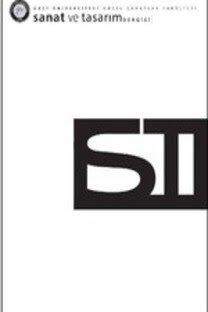MODA TASARIMI ÖĞRENCİLERİNİN TASARIM BİLİŞ TÜRLERİNİN BELİRLENMESİ
Tasarım teori ve strateji incelemeleri sonucunda yaratıcı tasarım düşüncesini geliştirme olanakları keşfedilmeye çalışılmaktadır. Tasarım araştırmaları, süreçlere ayrılan tasarım adımlarının zaman ve öncelik sıralamalarının farklı tasarım biliş türlerini ortaya çıkardığını ve tasarımcıların biliş türlerinin ölçek uygulamasıyla belirlemenin mümkün olduğunu göstermektedir. Bu araştırmanın temel amacı, moda tasarımı öğrencilerinin tasarım süreçlerini şekillendiren ve odaklandıkları tasarım biliş türlerinin, örneklemde yer alan üniversitelere ve öğrenim düzeyine göre incelenmesidir. Araştırmada, nicel araştırma yöntemlerinden genel tarama modellerinden ilişkisel tarama modeli kullanılmıştır. Araştırmada veri toplama aracı olarak 5’li likert tipinde 20 maddeden oluşan Tasarım Biliş Türü ölçeği kullanılmıştır. Örneklemdeki öğrencilerin, üniversitelere ve öğrenim düzeylerine göre tasarım biliş türü tercihlerine yönelik bulgular değerlendirilmiş ve tasarım süreçlerinde genel olarak sorun odaklı tasarım biliş türüne odaklandıkları sonucuna ulaşılmıştır. Örneklemin öğrenim düzeylerine göre tasarım biliş türü tercihleri de sorun odaklı tasarım biliş türüne yöneliktir. Üniversitelere ve üniversitelerin öğrenim düzeylerine göre ise farklı tasarım biliş türü tercihlerinin olduğu görülmektedir.
Anahtar Kelimeler:
Moda Tasarımı Eğitimi, Yaratıcılık, Tasarım Süreci, Biliş, Tasarım Biliş Türleri
DETERMINATION OF THE DESIGN COGNITION TYPES OF THE FASHION DESIGN STUDENTS
Through the analysis of design theory and strategy, the possibilities of developing creative design thinking are explored. Design research shows that the time and priority sequences of the design steps allocated to the processes reveal different design cognition types and it is possible to determine the designers’ cognitive types by scale application. The main purpose of this research is to examine the design cognition types focusing at the design process of fashion design students according to the universities and the level of education in the sample. In this study, relational survey model, which is one of the general survey models, is used. In the research, the Design Cognition Type scale consisting of 20 items in 5-point Likert type was used as data collection tool. Findings related to design cognition type preferences of the students in the sample were evaluated according to the universities and their education levels and it was concluded that the design processes generally focused on the problem-driven design cognition type. Design cognition type preferences according to the level of education of the sample are also at the problem-driven design cognition type. It is seen that there are different design cognition type preferences according to the universities and the education levels of the universities.
___
- • Anwar, R., Abidin, S. Z., & Hassan, O. H. (2015). A practical guideline to quantifying qualitative analyses of design cognition. The Turkish Online Journal of Educational Technology, 1, 13-21.
- • Ball, L.J., & Christensen, B.T. (2019). Advancing an understanding of design cognition and design metacognition: Progress and prospects. Design Studies, 65, 35-59.
- • Bayazıt, N. (1994). Endüstri ürünlerinde ve mimarlıkta tasarlama metodlarına giriş. İstanbul: Literatür Yayıncılık.
- • Carlson, S. E., Lewis, D. G. R., Maliakal, L. V., Gerber, E. M., & Easterday, M. W. (2020). The design risks framework: Understanding metacognition for iteration. Design Studies, 70, 100961.
- • Connor-Crabb, A., Miller, K., & Chapman, J. (2016). Design strategies for the eternal reoccurrence of the new. Fashion Practice, 8(1), 22-43.
- • Cross, N. (2001). Design cognition: Results from protocol and other empirical studies of design activity. C.M. Eastman vd. (Eds.), Design knowing and learning: Cognition in Design Education (79-103), Amsterdam: Elsevier Science.
- • Eastman, C. and Computing, D. (2001). New directions in design cognition: studies of representation and recall. In Design Knowing and Learning: Cognition in design education, Elsevier Science, 147-198.
- • Erdoğdu, M.Y., (2006). Yaratıcılık Değerlendirme Ölçeğinin Türk Kültürüne Uyarlanması. İnönü Üniversitesi Eğitim Fakültesi Dergisi, 7 (12), 61-79.
- • Gros, J. (1984). Reporting progress through product language. Innovation. The Journal of the Industrial Designers Society of America, Spring’den aktaran N. Cross (2001). Designerly ways of knowing: design discipline versus design science. Design Issues, 17(3), 49-55.
- • Gully, R. (2010). Cognition and process vs. design artifact in fashion design pedagogy. Cumulus Working Papers, 20 (09), 40-45.
- • Jones, S.J. (2009). Moda tasarımı. (Çev: H. Kılıç). İstanbul: Güncel Yayıncılık.
- • Karasar, N., (2009). Bilimsel araştırma yöntemleri, Ankara: Nobel Yayınları.
- • Kruger, C. and Cross, N., (2006). Solution driven versus problem driven design: strategies and outcomes. Design Studies, 27(5), 527-548.
- • Lu, C.C. (2015). The relationship between student design cognition types and creative design outcomes, Design Studies ,36, 59-76.
- • Molla, A. (2007). Giysi tasarımı aşamalarının incelenmesi ve hazır giyim işletmelerindeki tasarımcı performansının değerlendirilmesi. Yayımlanmamış Yüksek Lisans Tezi. Konya: Selçuk Üniversitesi, Sosyal Bilimler Enstitüsü.
- • Oxman, R. (2001). The mind in design: a conceptual framework for cognition in design education. In Design knowing and learning: Cognition in design education, Elsevier Science, 269-295.
- • Önal, G.K. (2014). Tasarım aktivitelerini araştırmak: protokol analiz yöntemi. Sanat ve Tasarım Dergisi, 1 (14), 65-80.
- • Sünbül, A.M., (2004).Düşünme Stilleri Ölçeğinin Geçerlik ve Güvenirliği. Eğitim ve Bilim Dergisi, 29 (132), 25-42.
- • Yanık, O. (2007). Yaratıcılık. İstanbul: Reklam Yaratıcıları Derneği BAMM Yayınevi.
- ISSN: 1308-2264
- Yayın Aralığı: Yılda 2 Sayı
- Başlangıç: 2015
- Yayıncı: Ankara Hacı Bayram Veli Üniversitesi
Sayıdaki Diğer Makaleler
FOTOĞRAF SANATINDA PORTRE TİPOLOJİLERİ
YAZI TASARIMINI ÖNEMSEYEN VE SAHİP ÇIKAN BİR KUŞAĞIN TEMSİLCİSİ: MUSTAFA EREN
GÖRSEL OKUMA VE TİPOGRAFİK AÇILIMLARI
Hande ÖZGELDİ BÜYÜKTOPBAŞ, Tevfik Fikret UÇAR
TÜRKİYE'DE HAREKETLİ AFİŞİN ONTOLOJİSİ
FRANK LLOYD WRIGHT'IN MEKAN ANLAYIŞI: FREDERICK ROBIE EVİ ÜZERİNDEN BİR OKUMA
''SOYLULAŞTIRMA'' KAVRAMI ÜZERİNDEN ÜRETİM YAPAN SANATÇILARA YÖNELİK BİR İNCELEME
İÇ MİMARLIK EĞİTİMİNDE ÖĞRENCİ PROFİLİ ODAKLI BİR DEĞERLENDİRME: BİR TASARIM STÜDYOSU DENEYİMİ
Özlem KURT ÇAVUŞ, Mustafa ÇAVUŞ, B.burak KAPTAN
TÜRKİYE'DE ÖZEL TİYATROLARA DEVLET YARDIMI: AMPİRİK BİR ANALİZ
